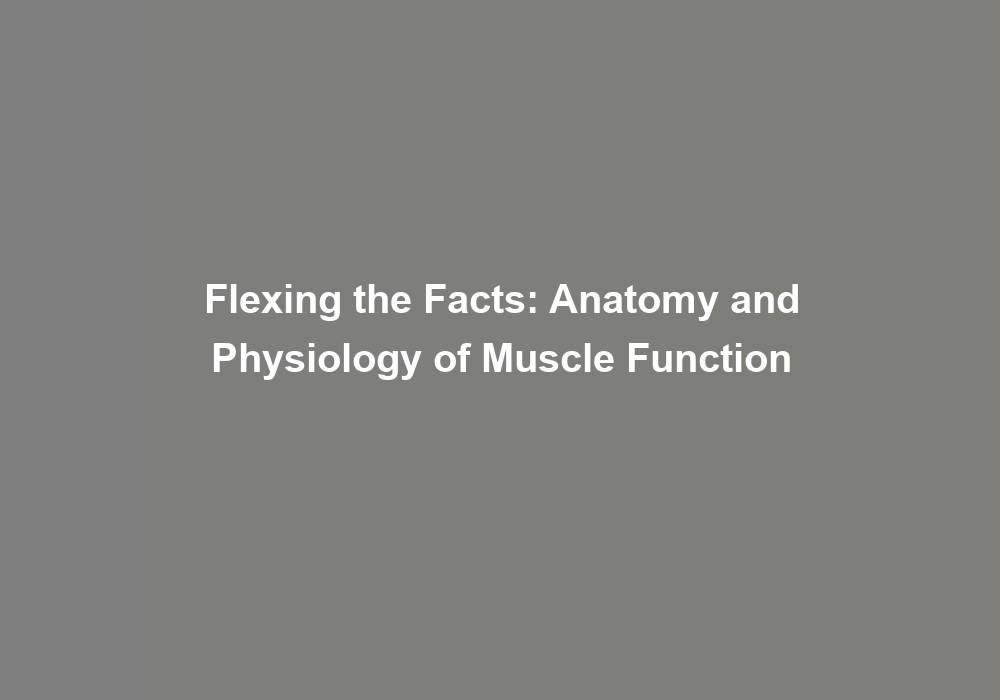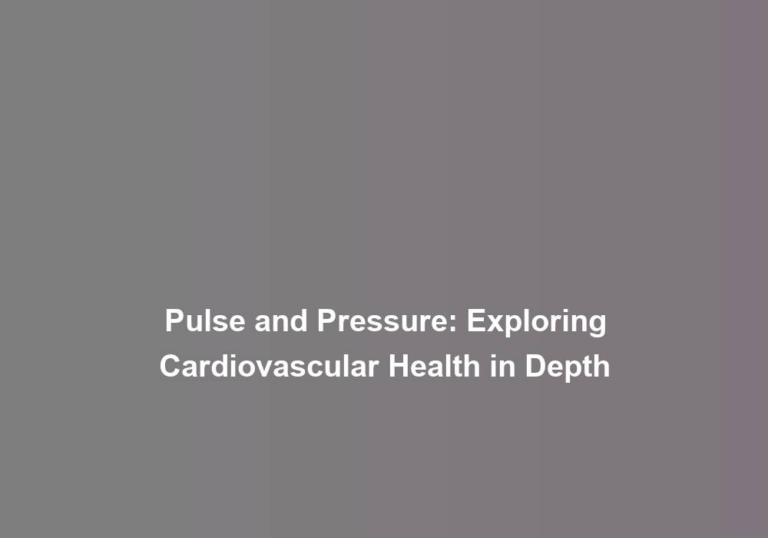Flexing the Facts: Anatomy and Physiology of Muscle Function
Have you ever wondered how your muscles function and adapt to different forms of exercise? Understanding the intricacies of muscle anatomy and physiology can provide valuable insights into how your body responds to physical activity. From the structure and composition of muscles to the role of the nervous system in muscle function, there are fascinating details that shed light on the remarkable capabilities of the human body. As you explore the mechanisms of muscle contraction, energy metabolism in muscle cells, and the adaptive responses to training, youG??ll gain a deeper appreciation for the complexity of muscle function and its implications for overall health and performance.
Muscle Structure and Composition
Understanding the muscle structure and composition is essential for grasping the functionality of the human body. When it comes to muscle fiber types, there are generally two main categories: slow-twitch fibers and fast-twitch fibers. Slow-twitch fibers are more endurance-oriented and are highly resistant to fatigue, making them well-suited for activities like long-distance running or cycling. On the other hand, fast-twitch fibers are better equipped for quick, powerful movements such as sprinting or weightlifting, but they fatigue more quickly. Each person has a unique proportion of these fiber types, influencing their athletic abilities and preferences.
Muscle protein synthesis is a crucial process that occurs within the muscle fibers, contributing to muscle growth and repair. When you engage in strength training or resistance exercises, small tears occur in your muscle fibers. In response, your body initiates muscle protein synthesis to repair and strengthen these fibers, leading to increased muscle mass and strength over time. Ensuring that your body has an adequate supply of protein, particularly essential amino acids, is essential for supporting this process and maximizing the benefits of your workouts.
Mechanism of Muscle Contraction
Having grasped the significance of muscle fiber types and protein synthesis in muscle function, you can now explore the mechanism of muscle contraction. When your muscle receives a signal from the nervous system, it triggers a series of events that lead to the sliding of actin and myosin filaments, resulting in muscle contraction. This process involves two main elements: cross bridge cycling and calcium signaling.
Cross bridge cycling is a crucial process in muscle contraction. As the signal from the nervous system reaches the muscle, it triggers the release of calcium ions from the sarcoplasmic reticulum. These calcium ions bind to troponin, causing a conformational change in the tropomyosin molecule, which then exposes the active sites on the actin filaments. This allows the myosin heads to form cross bridges with the actin, leading to the sliding of the filaments and muscle contraction.
Furthermore, calcium signaling plays a pivotal role in muscle contraction. The release of calcium ions triggers the interaction between actin and myosin, initiating the power stroke and causing the filaments to slide past each other. As the nerve signal diminishes, the calcium ions are pumped back into the sarcoplasmic reticulum, allowing the muscle to relax.
Understanding the intricate mechanisms of cross bridge cycling and calcium signaling provides valuable insight into the remarkable ability of muscles to generate force and movement. This knowledge empowers you to appreciate the complexity of muscle function and its significance in everyday activities.
Role of Nervous System in Muscle Function
The nervous system plays a crucial role in coordinating muscle function and movement. Nervous system communication is essential for muscle coordination and control. When you decide to move, your brain sends signals through the nervous system to the specific muscles involved in the action. This process involves a complex interplay between the central nervous system (CNS), which includes the brain and spinal cord, and the peripheral nervous system (PNS), consisting of the nerves that extend throughout the body.
At the core of muscle function is the interaction between motor neurons and muscle fibers. Motor neurons, originating in the spinal cord, transmit signals from the CNS to the muscles, initiating muscle contractions. These signals, known as action potentials, travel along the motor neurons and stimulate the release of neurotransmitters at the neuromuscular junction. The neurotransmitters then bind to receptors on the muscle fibers, triggering a series of events that ultimately lead to muscle contraction.
Furthermore, the nervous system ensures precise control over muscle movements. When you engage in activities requiring fine motor skills, such as writing or playing a musical instrument, the nervous system orchestrates the recruitment of specific muscle fibers and the coordination of muscle groups to achieve the desired movement. This level of control is made possible by the intricate feedback loops between the nervous system and the muscles, allowing for adjustments in muscle contractions to maintain stability and accuracy in movements. Understanding the role of the nervous system in muscle function provides insight into the remarkable coordination and control exhibited by the human body.
Energy Metabolism in Muscle Cells
Energy metabolism in muscle cells supports the intricate coordination of muscle function by providing the necessary fuel for muscle contractions and activities requiring fine motor skills. ATP production is at the core of energy metabolism in muscle cells. ATP, or adenosine triphosphate, is the energy currency of the cell and is essential for muscle contractions. As you engage in physical activities, such as lifting weights or running, your muscle cells require a substantial amount of ATP to support the continuous contractions and movements. This is where cellular respiration comes into play. Through the process of cellular respiration, muscle cells break down glucose and other nutrients to generate ATP. This ensures that your muscles have a constant supply of energy to sustain physical activities.
Understanding the energy metabolism in muscle cells is crucial for optimizing your performance during workouts or any physical activity. By knowing the mechanisms behind ATP production and cellular respiration, you can make informed decisions about your nutrition and training regimen. For instance, consuming foods that provide a source of readily available energy, such as carbohydrates, can help fuel your muscle cells during high-intensity exercises. Additionally, incorporating aerobic exercises into your routine can enhance your muscle cellsG?? capacity for cellular respiration, improving overall energy metabolism and endurance.
Muscle Adaptation and Response to Training
Improving your muscle strength and endurance through training involves a complex process of adaptation and response within the muscle cells. Training effects lead to various physiological changes in your muscles, helping them become more efficient and powerful. Muscle adaptation occurs as a result of consistent training, influencing the way your muscles respond to the demands placed upon them. Here are some key points to understand about muscle adaptation and response to training:
-
Hypertrophy: Your muscles can undergo hypertrophy, leading to an increase in muscle fiber size and overall muscle mass. This adaptation allows your muscles to generate more force and power during contractions.
-
Increased Endurance: Regular training can enhance the oxidative capacity of your muscles, enabling them to sustain prolonged activity with improved efficiency. This leads to greater endurance and delayed onset of muscle fatigue.
-
Strength Gains: Training effects include improvements in muscle strength, attributed to both neural adaptations and structural changes within the muscle fibers.
-
Improved Coordination: Muscle adaptation involves enhanced motor unit recruitment and coordination, resulting in smoother and more precise muscle contractions during movement.
-
Reduced Risk of Injury: Through training effects, your muscles develop greater resilience and adaptability, reducing the risk of injuries during physical activities.
Understanding these training effects and muscle adaptations can help you appreciate the remarkable changes occurring within your muscles as you engage in regular exercise routines.
Conclusion
So, now you know the ins and outs of muscle function. Just like a well-oiled machine, your muscles work together in perfect harmony to keep you moving and grooving. Whether youG??re lifting weights or going for a run, your muscles are always ready to flex their strength. Remember, your body is a work of art, and understanding the anatomy and physiology of muscle function is like unlocking the secrets of a masterpiece. Keep flexing, and embrace the power within you!







